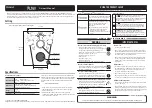
Tel: 886.2.2175 2930 Email: [email protected]
www.salukitec.com
15
2.2.3.
Power Safety
Precautions for the power supply of the instrument:
1) Ensure that the actual power supply voltage is the same as that marked on the instrument before powering-on. If the power supply
voltage is changed, replace the fuse of the instrument.
2) Refer to the power supply requirements on the rear panel of the instrument. Use three-core power cords. Ensure that the power
cord is grounded reliably. Floating or improper grounding may result in damage to the instrument and even operator injuries.
3) Do not damage the power cord; otherwise, electrical leakage may be caused, resulting in instrument damage and even operator
injuries. If any, check the external power cord or terminal block before operation to ensure the power safety.
4) If the power socket is not equipped with any ON/OFF switch, the power plug can be directly pulled off to power off the instrument. In
this case, ensure it is easy to plug and unplug the power line.
5) Do not use any damaged power cord. Before connecting the power cord to the instrument, check the power cord for integrity and
safety. Reasonably place the power cord to avoid the impact from human activities. For example, the operator may fall over if the
power cord extends over long distances.
6) The TN/TT power network is required. The maximum rated current of the fuse should be 16A (contact the manufacturer if a fuse of
higher current is required).
7) Keep the socket clean and the plug and the socket in good and firm contact.
8) The socket and power cord must not be overloaded; otherwise, fire or electric shock may be caused.
9) If the voltage Vrms is higher than 30V in the test, take appropriate protective measures (such as use of the appropriate test
instrument and fuse, limitation of the current, electrical isolation and insulation, etc.) to avoid damage to the instrument.
10) The instrument shall conform to IEC60950-1/EN60950-1 or IEC61010-1/EN61010-1 so as to realize the connection to a PC or
industrial personal computer.
11) Unless specially permitted, the instrument shell must not be opened; otherwise, internal circuits and parts may be exposed,
resulting in unnecessary damage.
12) If the instrument needs to be fixed in a test place, the protective ground wire should be installed between the test place and
instrument by the electrician with qualifications.
13) Take appropriate overload protection measures to avoid instrument damages or personal injuries caused by overload voltage
(arising from lightning, etc.).
14) If the instrument shell is opened, unnecessary parts must not be placed into the shell; otherwise, short circuiting, instrument
damages and even personal injuries may be caused.
15) Unless otherwise stated, the instrument is not subject to waterproof protection. Therefore, the instrument must not contact with
liquid to prevent damages and even personal injuries.
16) The instrument must not be placed in a place where mist can be easily produced. For example, if the instrument is handled in an
environment with temperature fluctuation, hazards such as electric shock may be caused by water drops produced on the
instrument.
















































